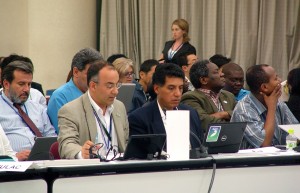O leigo geralmente acredita que as patentes só servem para proteger invenções. As empresas que patenteiam genes desde os anos 80 sabem que isto não é verdade.
O debate lançado de surpresa pelo governo Obama na 6a feira passada -- ao se posicionar contra o patenteamento de genes que são produtos da natureza -- promete finalmente esquentar a questão da patenteabilidade de coisas que não são invenções, como os genes encontrados na natureza e simplesmente isolados dos seres vivos nos quais funcionavam.
O que está pegando é que centenas de patentes genéticas que impõem monopólios sobre o uso de coisas naturais -- como por exemplo marcadores genéticos para determinadas doenças -- constituem o motor da dinâmica daquilo que os grandes laboratórios transnacionais (da farmacêutica, sementes, etc.) teimam em chamar de progresso e concorrência.
A saudável polêmica já está dando pano para manga em órgãos como o NYT.
Em tempo, aqui no Brasil, a Lei de Propriedade Industrial (Nº 9.279/96), ao implementar as exigências do Acordo TRIPs (artigo 27-3[b]) da OMC, está alinhada justamente com a nova posição do governo dos EUA. Há quase 15 anos, o Brasil decidiu que o único material biológico que é uma invenção e é patenteável é um microorganismo transgênico, e que outros organismos (principalmente as plantas e os animais) simplesmente não são patenteáveis, mesmo quando forem transgênicos. Na prática, obviamente, a teoria é outra. O INPI está cansado de conceder patentes brasileiras para a Embrapa, Monsanto, DuPont, Basf, Bayer, Syngenta e outras comparsas sobre suas sementes RR, Bt, e etc.
Mas isto seria pano para outra manga. Comemoremos, por enquanto, a luz que deu no Departamento da Justiça, lá em Washington!
===================
New York Times, November 1, 2010
http://www.nytimes.com/2010/11/02/health/02gene.html
Gene Patent Ruling Raises Questions for Industry
By ANDREW POLLACK
When the Justice Department declared in a court filing late Friday that genes should not be eligible for patents because they are products of nature, Harold C. Wegner, an
influential patent lawyer in Washington, did not mince words.
“Eric Holder Hijacks the Patent System, Flunks Patents 101,” Mr. Wegner wrote in an e-mail to 1,250 people, referring to the attorney general.
Sharp reaction greeted the declaration that human and other genes are not patentable, a reversal of what had been the government’s policy for decades.
One patent lawyer characterized the new position as dumb. The Biotechnology Industry Organization warned that such a policy, if carried out, would “undermine U.S. global leadership and investment in the life sciences.”
But the new stance cheered those who believe that such patents retard rather than spur medical progress and interfere with people’s access to information about themselves.
“If you want to look at your own genome and see if you have a mutation, you should be able to do that without paying a license fee to someone else,” said Steven Salzberg, a professor of computer science and genetics at the University of Maryland.
The government’s new policy was outlined in a friend of the court brief in a lawsuit challenging patents held by Myriad Genetics and the University of Utah Research Foundation on two genes that are linked to breast and ovarian cancer.
The reversal appears to be a result of discussions among agencies within the Obama administration, including the National Institutes of Health and the Patent and Trademark Office. In the short run, however, it appears the new policy will have little practical impact. The patent office said in a statement that it would not immediately put the policy into effect and would not start denying patents on genes because of pending litigation.
The office will “maintain the status quo while this matter is pending resolution by the Federal Circuit Court of Appeals,” a spokesman said, referring to the case on the cancer risk genes. A lower court had ruled against Myriad, deciding that human genes could not be patented.
An administration official said it would be too disruptive to change the longstanding patent policy now, since the court might end up ruling the other way on the case involving the cancer risk genes. Over two decades, the agency has issued thousands of patents on genes.
The patent office appears to have opposed the position taken in the Justice Department’s brief. None of its lawyers were listed as authors.
Mr. Wegner, who is at the firm Foley & Lardner, said he had talked recently with David J. Kappos, the director of the patent office. He said Mr. Kappos “seemed chagrined that the Department of Justice was taking a viewpoint very different from the patent office.”
The patent office said it had no further comment.
In the lawsuit at issue, medical societies, researchers and patients have sued Myriad and the research foundation, which have patents on the two genes, BRCA1 and BRCA2. Myriad sells a test for more than $3,000 that detects mutations in the genes that confer a very high risk of breast or ovarian cancer.
In March, Judge Robert W. Sweet of the United States District Court in Manhattan ruled that the patents were invalid. Now, with the case before the appeals court, the Justice Department has essentially agreed with him.
“Clearly, this is a major development,” said Chris Hansen, a lawyer at the American Civil Liberties Union, which is representing the plaintiffs. “In effect, the United States government has joined the plaintiffs.”
But Myriad pointed out in a statement on Monday that the Justice Department also agreed with the company on other issues.
Gauging the effect of a policy against patenting genes, should it be carried out, is somewhat difficult. Part of it depends on whether it would apply just to new patents or whether it would be used to revoke existing gene patents.
James P. Evans, a professor of genetics and medicine at the University of North Carolina who has studied gene patents, said that there were mainly two companies, Myriad and Athena Diagnostics, that based their business on offering expensive genetic tests protected from competition by gene patents.
Diagnostics, he said, was moving toward tests using multiple genes, or even a person’s entire genome sequence. Patents on each individual gene could be a barrier to development of those multigene tests, he said.
Professor Salzberg of the University of Maryland has developed a computer program that can analyze a person’s genome for mutations in the BRCA1 and BRCA2 genes. “We did it to show how it would be easy today for someone to get their genome sequenced and to do their own genetic testing,” he said.
Right now, it costs $10,000 or more to get a personal genome sequence. But in a few years, it is expected to cost only $1,000 or so. It might then be possible to have one’s DNA sequenced and analyzed for mutations in hundreds of genes for less than Myriad charges for two genes.
Kevin E. Noonan, a patent lawyer in Chicago who represents biotechnology companies, said that many companies no longer tried for patents on DNA isolated directly from the genome, the type the Justice Department brief says should not be patented. They obtain patents on manipulated DNA, which the Justice Department said could be patented.
Still, Mr. Noonan, who is an author of Patent Docs, a blog on biotech patent issues, said the government’s stance would endanger innovation because the same philosophy against patenting products isolated from nature might be extended to protein-based drugs and antibiotics.
“It’s dumb,” Mr. Noonan said of the government’s brief. “It shows a singular ignorance of the technology and the law at the same time.”
Mr. Wegner, whose firm also represents some biotech companies, said the government’s stance could make it harder for Washington to get other countries to protect intellectual property. “We’re telling the rest of the world to have high minimum standards to protect software, pharmaceuticals,” he said, “and we’re violating minimum standards ourselves.”
In its brief to the appellate court, Myriad argued that the plaintiffs did not have standing to sue because Myriad was not accusing them of infringement.
Judge Sweet in the lower court rejected those arguments. But if the appeals court accepted them, it could decide the case without having to weigh the merits of gene patents. It is not clear if the policy against gene patents would then be put into effect.


